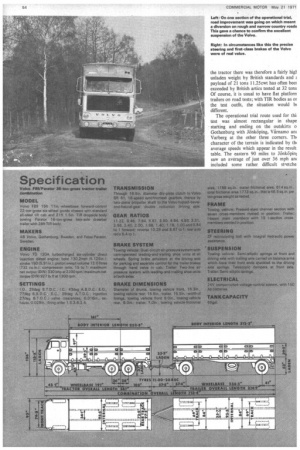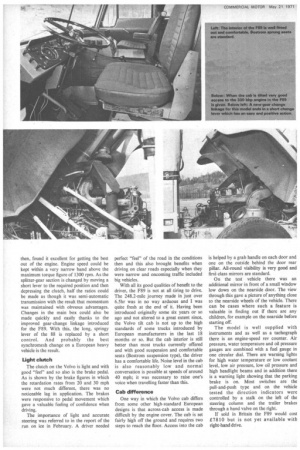„I* Volvo F89/Parator ROAD 38-ton-gtw
Page 55

Page 56

Page 57

Page 58

If you've noticed an error in this article please click here to report it so we can fix it.
9171
and operational
trial Combinationb„onyw„ding, MiMechE HAVING had experience of the Volvo F89 after the 382-mile long run organized in Sweden by the manufacturer earlier this year (CM, February 12), I knew what to expect when offered the chance of a full road test of the model. The quality of the design was demonstrated in February. It was confirmed on this test which was also carried out in Sweden but in normal conditions instead of over snow-coveret roads.
The new Volvo 330 bhp six-in-line 12-litre diesel provided ample powefor the 38-ton gross weight of the truck and trailer combination even on the hilly sections of a 248.2-mile test route. With a powerto-weight ratio of 8.7 bhp per ton there was relatively little gear changing to be done even on the arduous sections of the route, which is one reason for surprising consistency in fuel consumption figures— they varied from 6.0 to 6.5 mpg comparing the worst and the easiest sections. Overall consumption was a commendable 6.2 mpg, exactly the same as for this combination when it was one of the participants in the February exercise.
First figures
During the earlier two-day run, none of the European Press representatives taking part had the chance of carrying out their own test procedures (despite contrary impressions given elsewhere) so this was the first chance to obtain brake figures and acceleration times, etc. The F89 produced through-the-gears acceleration results more in keeping with medium-weight trucks or high-powered 16-ton-gross chassis, (Directdrive tests were not carried out as the vehicle would not pick up speed in this gear even from 20 mph.) Braking results were also up to the standard of outfits running at a much lower gross weight. Although stopping distances were greater than when I tested the lower-powered Volvo FB88 last year they were about normal for 32-ton ardcs; the difference between the FB88 results and the current ones must have been due to adjustment or other factors as the
F89 has an identical brake system of brake actuation, the only change being to the use of lin.-wider shoes all round.
On this test a shorter operational trial route was used because the vehicle was not available for a two-day run. There was, however, no appreciable difference in the character of the journey, there being comparable proportions of easy and difficult terrain. It was therefore interesting that the F89 gave 6.2 mpg overall as against 6.04 mpg for the FB88 and with an improved average speed of 37.5 mph as against 36.7 mph. This shows that extra power does not damage fuel consumption and in fact can improve the position in certain circumstances.
Both the Volvo and the Parator trailer used on this test had higher kerb weights than the tractor and trailer on the earlier test. The increase was due mainly to the fact that both had additional tilt frames and canopies. The trailer was actually the same one as used with the FB88 yet weighing 14cwt. more. With the same weight extra on the tractor there was therefore a fairly higl unladen weight by British standards and payload of 21 tons 11.25cwt has often beer exceeded by British allies tested at 32 tons Of course, it is usual to have flat platforrr trailers on road tests; with TIR bodies as or the test outfit, the situation would b4 different.
The operational trial route used for thi: test was almost rectangular in shape starting and ending on the outskirts o Gothenburg with Jonkoping, Varnamo am Varberg at the other three corners. Thi character of the terrain is indicated by till average speeds which appear in the result table. The eastern 90 miles to ninkopim saw an average of just over 36 mph ant included some rather, difficult stretche especially the first seven miles when the road was narrow and winding with many hills. Here it was not possible to run for long above about 37 mph but then it improved and the road was wider with some narrow and winding sections still and generally fairly hilly.
The 40-odd miles from JOnkOping to Varnaino was on E4. an altogether better road, quite wide and relatively flat. The result was an average speed of almost 40 mph. Turning west the road was quite narrow again for a short way but then there had been a lot of road improvement work making a good quality road and better than the first section but worse than E4 in the number of hills encountered. At times, on the latter part of this leg, road improvement was in progress, which made for difficulty and at one point there was a diversion over difficult country roads for about four miles. The Volvo did well to average over 37 mph on this part. At Varberg we picked up the E6, another good quality trunk route for the final northern leg to Gothenburg. There was a lot of traffic about as compared to the very quiet roads previously but we did not get held up and kept pace with the rest at between 45 and 50 mph, the speed aimed at for all parts of the journey.
An important factor in being able to put up such good averages was the Volvo SR 61 synchromesh gearbox in the test vehicle. This is the Volvo eight-speed range-change ,box with the addition of splitter gearing to 'make 16 overall transmission ratios. As will be seen from the maximum speeds in the gears quoted in the results table, every one of the 16 gears is useful and the spacing between them all is even.
I have driven with this box before and as then, found it excellent for getting the best out of the engine. Engine speed could be kept within a very narrow band above the maximum torque figure of 1300 rpm. As the splitter-gear section is changed by moving a short lever to the required position and then depressing the clutch, half the ratios could be made as though it was semi-automatic transmission with the result that momentum was maintained with obvious advantages. Changes in the main box could also be made quickly and easily thanks to the improved gear-change linkage introduced for the F89. With this, the long, springy lever of the 88 is replaced by a short control. And probably the best synchromesh change on a European heavy vehicle is the result.
Light clutch The clutch on the Volvo is light and with good "feel" and so also is the brake pedal. As is shown by the brake figures in which the retardation rates from 20 and 30 mph were not much different, there was no noticeable lag in application. The brakes were responsive to pedal movement which gave a valuable feeling of confidence when driving.
The importance of light and accurate steering was referred to in the report of the run on ice in February. A driver needed perfect "feel" of the road in the conditions then and this also brought benefits when driving on clear roads especially when they were narrow and oncoming traffic included big vehicles.
With all its good qualities of benefit to the driver, the F89 is not at all tiring to drive. The 248.2-mile journey made in just over 6.5hr was in no way arduous and I was ciente fresh at the end of it. Having been introduced originally some six years or so ago and not altered to a great extent since, the Volvo tilt cab is not up to the high standards of some trucks introduced by European manufacturers in the last 18 months or so. But the cab interior is still better than most trucks currently offered and with good suspension and comfortable seats (Bostrom suspension type), the driver has a comfortable life. Noise level in the cab is also reasonably low and normal conversation is possible at speeds of around 40 mph; it was necessary to raise one's voice when travelling faster than this.
Cab difference One way in which the Volvo cab differs from some other high-standard European designs is that across-cab access is made difficult by the engine cover. The cab is set fairly high off the ground and requires two steps to reach the floor. Access into the cab is helped by a grab handle on each door and one on the outside behind the door rear pillar. All-round visibility is very good and first-class mirrors are standard.
On the test vehicle there was an additional mirror in front of a small window low down on the nearside door. The view through this gave a picture of anything close to the nearside wheels of the vehicle. There can be cases where such a feature is valuable in finding out If there are any children, for example on the nearside before starting off.
The model is well supplied with instruments and as well as a tachograph there is an engine-speed rev counter. Air pressure, water temperature and oil pressure gauges are combined with a fuel gauge in one circular dial. There are warning lights for high water temperature or low coolant level, low air pressure, low oil pressure and high headlight beams and in addition there is a warning light showing that the parking brake is on. Most switches are the pull-and-push type and on the vehicle tested the direction indicators were controlled by a stalk on the left of the steering column and the trailer brakes through a hand valve on the right.
If sold in Britain the F89 would cost £7810 but is not yet available with right-hand drive.






























































































































